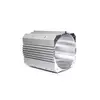Mobile:+86-311-808-126-83
Email:info@ydcastings.com
English
Exploring the World of Custom Die Cast Models for Unique Collectibles and Enthusiasts
The Art of Die Cast Customization
Die casting is a manufacturing process that has long been favored for its ability to produce intricate shapes and components with precision. This method, involving the injection of molten metal into a mold, has evolved not only for industrial applications but also as a canvas for creativity and customization. The topic of die cast custom pieces is not only intriguing but also embodies the intersection of art and engineering.
Die cast customizations allow individuals and companies to create unique products that reflect personal style or brand identity. From automotive parts to collectible figurines, die casting can produce items with remarkable detail and quality, which can be further enhanced through custom finishes and designs. This customization can involve various processes, including surface treatments, paint applications, and even the addition of custom logos or identifications.
One of the most popular realms of die cast customization is the world of collectibles, particularly in the realm of toy vehicles. Manufacturers like Hot Wheels and Matchbox have embraced die casting to create miniature replicas of real cars. Collectors often seek custom die cast vehicles that feature rare colors, unique graphics, or specific detailing that sets them apart from mass-produced items. Such custom pieces can significantly enhance a collector’s portfolio, often increasing in value over time.
Custom die cast products also play a significant role in promotional merchandise. Businesses often opt for die cast items that they can customize with their logos and branding messages. These items serve as giveaways or promotional gifts, making a lasting impression on clients and customers. Whether it’s a keychain, a model car, or a mini aircraft, customizing die cast items allows companies to merge functionality with branding.
die cast custom

The process of creating custom die cast pieces typically starts with design. Utilizing computer-aided design (CAD) software, designers can create 3D models that serve as prototypes for the die casting molds. This phase is crucial, as it allows for precise measurements and the ability to visualize the final product before it goes into production. Once the design is finalized, the mold is created, and the customized die casting process commences.
After casting, the finishing touches are applied. This can include polishing, painting, powder coating, or the application of decals. Each of these processes not only enhances the visual appeal of the item but can also affect its durability and usability. Custom finishes can make an ordinary product extraordinary, emphasizing colors, textures, and designs that resonate with the customer’s vision.
However, customization goes beyond aesthetics; it offers the capacity for innovation in functionality. For instance, customized die cast components can be engineered to fit specific mechanical purposes, enhancing their performance in various applications. This versatility is particularly beneficial for industries like aerospace or automotive, where precise specifications are critical for safety and efficiency.
The rise of technology has further expanded the possibilities of die cast customization. Advanced manufacturing techniques such as 3D printing and additive manufacturing can complement traditional die casting processes, allowing for more complex designs and rapid prototyping. This integration facilitates a more flexible approach to customization, enabling faster turnaround times and the ability to test multiple designs before settling on a final product.
In conclusion, die cast custom pieces represent a vibrant fusion of industry and artistry. Whether in the realm of collectibles, promotional products, or functional components, the ability to customize die cast items opens a world of creativity and innovation. As technology continues to advance, the prospects for die casting customization will only broaden, allowing for even more ingenious designs and applications in the future. The art of die cast customization not only enhances products but also enriches the experience of creators and consumers alike.
-
Premium Fan Housing & Motor Casing for Optimal AirflowNewsAug.31,2025
-
High-Performance Automobile Water Pump & Electric SolutionsNewsAug.30,2025
-
Expert Stainless Steel Casting | Precision & Durable Metal PartsNewsAug.29,2025
-
Precision Metal Castings: Aluminum, Stainless Steel & Die CastingNewsAug.28,2025
-
Superior Aluminum Castings in Automotive Engine PartsNewsAug.22,2025
-
Common Materials Used in Fan Housing ManufacturingNewsAug.22,2025











